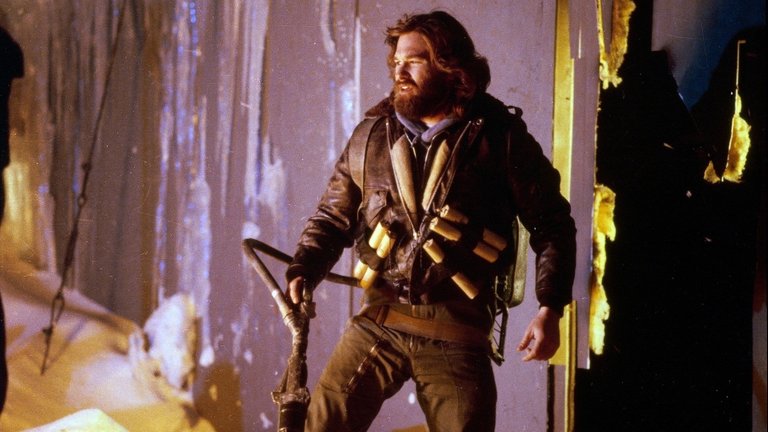
1982 was annus mirabilis ("wonderful year") for cinephiles, especially those who liked high quality and groundbreaking science fiction films. On the other hand, it also meant that some otherwise very good pieces of that genre failed merely for having to compete with the likes of E.T., Star Trek II: The Wrath of Khan, Mad Max 2 or Blade Runner. Such was the fate of John Carpenter's The Thing.
The film is based on "Who Goes There?", 1938 classic science fiction novella by Joseph Campbell, Jr., which was in 1951 adapted into black-and-white classic film The Thing from Another World. Modern film version has the plot set in Antarctica during winter and the protagonists are the crew of US research station. Monotony of their life, marked by bad weather, poor communications and sense of isolation is ended with arrival of Norwegian helicopter whose crew desperately tries to shoot a dog. Norwegians die before they have opportunity to explain their actions, and the dog is adopted by Americans. Dr. Cooper (played by Richard Dysart) and helicopter pilot MacReady (played by Kurt Russell) are sent to Norwegian station to investigate. There they find destruction, corpses and charred remains of large humanoid creature which is later subject of autopsy by station's biologist Dr. Blair (played by Wilford Brimley) who finds human organs in it. Further investigation discovers that Norwegians have found huge alien ship buried in permafrost and later dug it out, as well as a strange creature which was also buried nearby. Blair concludes that the creature, dubbed "The Thing", has the ability to assimilate and perfectly mimic other living organisms. By that time it is too late, because the escaped Norwegian dog has been revealed to be an imitation and that he probably began assimilate and mimic people at American station. Remaining members of the crew, faced with series of disturbing accidents, are now beset with paranoia because they have all the reasons to believe that the monstrous alien might be one of them. They must use all of their skills and resources not only to survive, but also to prevent the "The Thing" from reaching civilised areas and infecting the rest of humanity.
The Thing was the most expensive and the most ambitious film in John Carpenter's filmography by that time. It had disappointing results at the box office and was almost universally panned by critics, mostly unhappy with the huge amounts of violence and disturbing displays of gore. In subsequent years The Thing fared much better with video distribution and its reputation grew, gradually allowing it to be hailed as a masterpiece and one of the genre classics. The Thing is indeed a very good film. Script by Bill Lancaster is much more faithful to the original novella than 1951 version and it very skilfully uses plot elements of genre classics like 1979 Alien and Invasion of the Body Snatchers, while mixing it with the Agatha Christie's mystery classic And Then There Were None. Carpenter directs film very competently, using the services of cinematographer Dean Cundey who gives this film perfect combination of light and shade in order to depict isolated, claustrophobic setting where the protagonists are bound to experience fear, paranoia and cabin fever. Film also benefits from the great work on special effects by Robin Bottin who, assisted by Stan Winston, created part-human part-animal monstrosities which are believable and impressive despite being built without help of today's CGI technology. Furthermore, the script wisely decided to keep the number of characters relatively low and have no women in the film, thus simplifying plot and taking away an excuse for distracting romantic subplots. The Thing is well-cast, with Carpenter's old associate Russell giving another iconic performance, aided by some well-known character actors like Brimley and Dysart. Film ends very fittingly in a way that discards conventional happy end for the sake of one of the most ambiguous finales in the history of the cinema.
The Thing, however, had its share of flaws. Most obvious is in the script and due to inevitable comparisons with Alien which features the same basic concept of small band of characters having to fight monster at isolated location. Unlike characters in Ridley Scott's film, protagonists of The Thing aren't well-written nor particularly memorable, nor the audience has strong reasons to root for them, even in the case of MacReady who is portrayed as cold, cynical and anti-social only to become heroic leader near the end. The number of characters could have been further reduced, thus taking away some of the repetitive and at times predictable scenes of their demises. Music score by Ennio Morricone is quite unremarkable, except for great Italian composer showing great skill in mimicking previous musical scores by John Carpenter. The Thing is nevertheless very effective science fiction horror film that could impress audience even to this day. Its reputation, unlike some other genre classics, only grew better and remained unspoiled by sequels (with exception of usually panned 2011 prequel also titled The Thing). This is an achievement John Carpenter should be proud of.
RATING: 7/10 (++)
Blog in Croatian https://draxblog.com
Blog in English https://draxreview.wordpress.com/
Leofinance blog https://leofinance.io/@drax.leo
Cent profile https://beta.cent.co/@drax
Minds profile https://www.minds.com/drax_rp_nc
Uptrennd profile https://www.uptrennd.com/user/MTYzNA
Hiveonboard: https://hiveonboard.com?ref=drax
Rising Star game: https://www.risingstargame.com?referrer=drax
1Inch: https://1inch.exchange/#/r/0x83823d8CCB74F828148258BB4457642124b1328e
BTC donations: 1EWxiMiP6iiG9rger3NuUSd6HByaxQWafG
ETH donations: 0xB305F144323b99e6f8b1d66f5D7DE78B498C32A7
